Applications of Agricultural Drones in Modern Farming
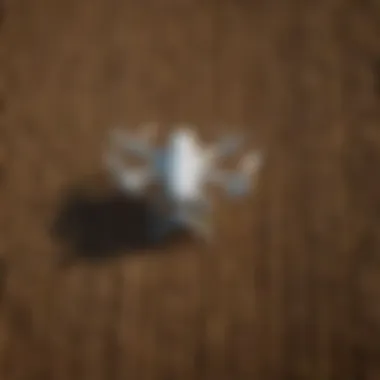
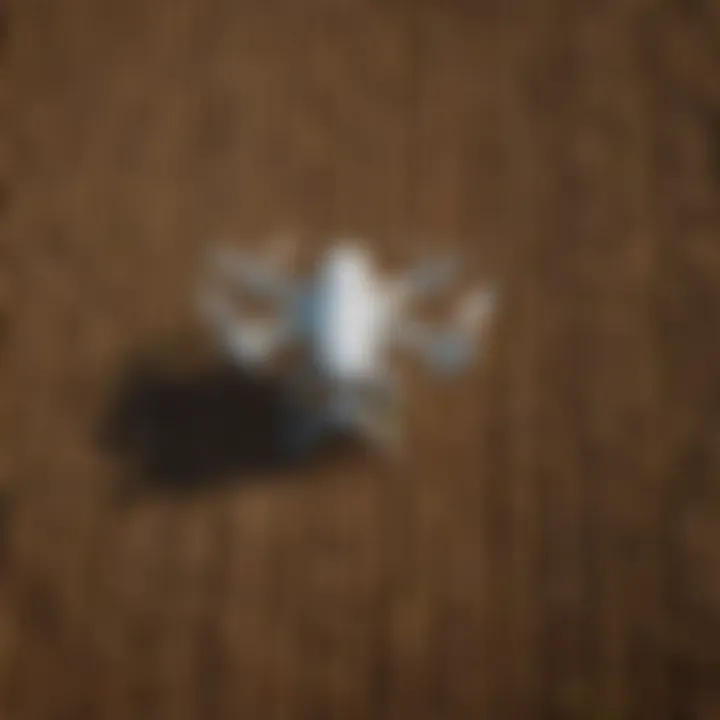
Intro
Agricultural drones are reshaping the landscape of farming in ways that were once relegated to science fiction. These unmanned aerial vehicles (UAVs) are becoming indispensable for farmers and agronomists alike, offering a blend of efficiency and productivity that cannot be overlooked in modern agricultural practices. They possess the unique ability to gather detailed data from the skies, allow for precision farming, and enhance pest control measures—all while minimizing human labor.
Understanding the nuances of agricultural drones is paramount for those endeavoring to stay ahead in the farming world. The applications of these drones span across various aspects of agriculture, including crop management, environmental monitoring, and even soil health assessment. With the overarching goal of increasing yield and sustainability, the incorporation of drone technology makes practical sense. This discussion will unpack these myriad applications, while also considering the challenges that accompany this innovative technology.
Overview of the Topic
Definition and Importance
Agricultural drones, simply put, are specialized UAVs designed for agricultural use. They can capture aerial imagery and collect real-time data, which helps farmers make informed decisions about their crops. This is increasingly crucial in a world facing rising population numbers and diminishing arable land. By employing drones, farmers can not only identify the health of their crops but also streamline their operations, thereby maximizing productivity.
"The key advantage of agricultural drones lies in their ability to collect high-quality data swiftly, creating actionable insights that can significantly boost yield."
Current Trends
The integration of drones into agriculture is not merely a fad; it reflects a significant trend towards precision agriculture. With the emergence of advanced drone technologies, there's been a notable surge in the adoption of drone usage across various agricultural sectors. For instance, farmers are now using drones equipped with multispectral cameras to assess crop health, monitor irrigation systems, and even detect disease outbreaks early on. Moreover, advancements in AI and machine learning are paving the way for even smarter drones capable of automated monitoring and decision-making.
Key Techniques and Practices
Step-by-Step Guide
- Setting Up Your Drone
- Planning Your Flight
- Executing the Aerial Survey
- Data Analysis
- Begin by selecting a drone model suitable for your farming needs. Consider the payload capacity, flight time, and camera specifications. Popular drones in agriculture include the DJI Phantom 4 RTK and the Parrot Bluegrass.
- Once you have your drone, it's time to install the necessary software for data collection and analysis.
- Utilize mapping software to define the areas you wish to cover.
- Pre-flight checks are crucial—ensure that the drone is in working condition, the batteries are charged, and the area is clear of obstructions.
- Launch the drone and monitor its flight using a remote control or a mobile device.
- Collect data using the appropriate sensors or cameras, ensuring you cover the entire area of interest.
- Post-flight, analyze the data using specialized software, which can help you create detailed maps indicating crop health and other important metrics.
Tools and Equipment Needed
To enhance your agricultural drone experience, having the right tools is essential. This can consist of:
- High-resolution cameras (multispectral or thermal)
- Data processing software (such as Pix4D or DroneDeploy)
- Reliable battery backups
- A good quality remote control or mobile device for monitoring.
Challenges and Solutions
Common Obstacles
Despite the benefits, there are hurdles that farmers might encounter when integrating drones into their operations. Issues like regulatory constraints can have a significant impact. Proper licensing is often necessary to comply with aviation laws, and this can differ from region to region. Data management and connectivity in remote areas may also present challenges when trying to analyze drone-collected data.
Innovative Solutions
To navigate these challenges, farmers can take several steps:
- Understanding regulations: Engaging with local authorities to get the necessary permits and licenses.
- Investing in robust connectivity options: Solutions such as satellite internet can help in managing data in rural locations.
- Training and education: Continuous learning about the technology can empower farmers to make the most of the data available through drone utilization.
Preamble to Agricultural Drones
The advent of agricultural drones marks a pivotal shift in modern farming methods. These innovative tools, designed to enhance productivity and efficiency, are no longer just a fancy gadget for tech-savvy farmers; they are becoming essential instruments that help tackle the challenges of today’s agriculture. Drones can gather vast amounts of data swiftly, allowing farm managers to make informed decisions quickly. In a nutshell, the blend of technology and agriculture offers promising avenues for better crop management, environmental sustainability, and economic viability.
Definition and Overview
Agricultural drones, or UAVs (Unmanned Aerial Vehicles), are aircraft that can be flown autonomously or controlled remotely. These drones aren’t just mere flying machines; they come equipped with advanced technologies that allow them to collect data on crop health, soil characteristics, and even pest presence. The versatility of these gadgets is staggering. They can be used for everything from aerial surveys to real-time monitoring of fields.
Historical Development
Looking back, the use of drones in agriculture has evolved significantly. Initially, the technology was limited to military and reconnaissance purposes. However, as drone technology became more accessible and affordable, farmers started to catch wind of its potential. From simple photography to sophisticated multi-spectral imaging, the development trajectory has brought powerful tools to the fingertips of farmers, enabling them to see their fields from a bird's eye view without breaking a sweat. This marked a turning point where precision farming began to gain traction among agriculturalists worldwide.
Key Components of Agricultural Drones
Flight Mechanisms
Flight mechanisms are the backbone of agricultural drones, dictating how these machines navigate the vast skies above farmland. Typically, they come in two main configurations: multirotors and fixed-wing designs. Multirotors provide excellent maneuverability and are fantastic for capturing detailed images over smaller areas, making them ideal for vineyard inspections or localized crop health checks. On the other hand, fixed-wing drones glide over large expanses, covering more ground in a shorter time, beneficial for extensive farming operations. However, these machines have their quirks; while multirotors are agile, they might need frequent battery swaps, whereas fixed-wing models require a bit more space for takeoff and landing.
Sensors and Imaging Technologies
The heart of a drone's ability to collect actionable data lies in its sensors and imaging technologies. Common attributes include multispectral cameras that can capture data outside the visible spectrum, providing insights into the health of crops that the naked eye can't discern. Thermal imaging sensors detect temperature variations, useful for identifying water stress in crops or distinguishing between healthy and unhealthy plants. While this technology brings about a wealth of knowledge to farmers, it is worth noting that the initial investment might be hefty. However, the return on this investment can be significant when it leads to better yields and reduced losses.
Data Processing Systems
Once the data is captured, the next challenge is to make sense of it. Data processing systems play a crucial role in turning aerial snapshots into actionable insights. With advanced algorithms, these systems can analyze data to provide comprehensive reports—ranging from health assessments to projected yields. The ability to process and visualize data in real-time can significantly enhance decision-making. However, it requires a solid grasp of software tools and agricultural knowledge, presenting a hurdle for some farmers. The benefits of timely, clear information can't be understated; they often mean the difference between a good harvest and a poor one.
"The efficient use of agricultural drones enables farmers to optimize operations, reduce waste, and potentially increase their profitability."
Agricultural Drone Technologies
Agricultural Drone Technologies provide the backbone to modern farming practices by offering a range of capabilities that enhance efficiency, precision, and overall productivity. These technologies facilitate the gathering and analyzing of data critical for informed decision-making, allowing farmers to address crop needs more effectively. Utilizing drones can translate to improved crop yields, reduced costs, and minimized environmental impact, making them a vital element in the contemporary agricultural landscape.
Types of Drones Used in Agriculture
When it comes to agricultural drones, there are several types that serve various functions and cater to different needs in the field.
Multirotors
Multirotors are a popular choice among farmers due to their versatility and maneuverability. These drones have multiple rotors, allowing them to hover steadily above fields and cover specific areas with precision. This characteristic makes them particularly suitable for targeted applications like crop spraying or monitoring specific plot sections.
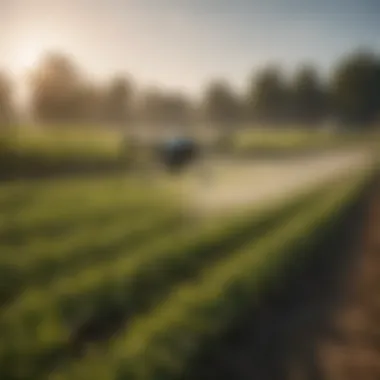
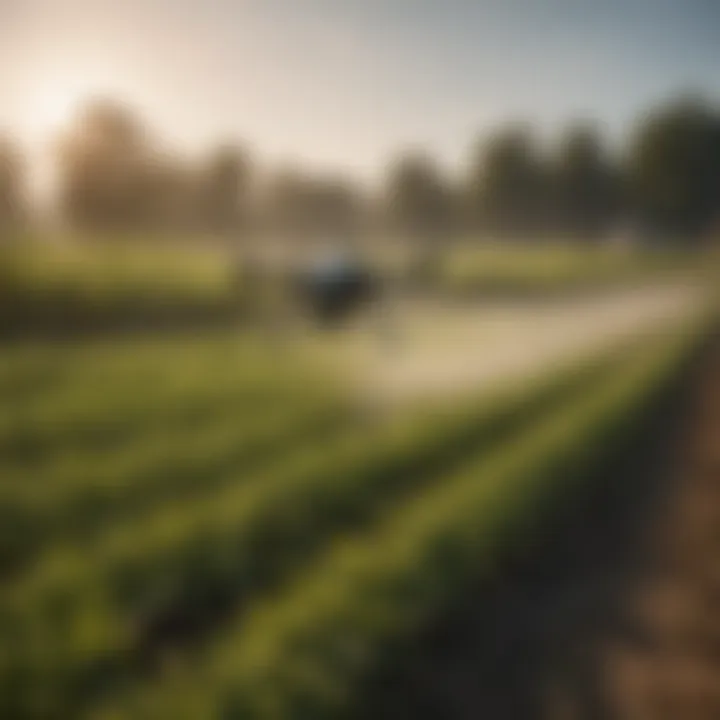
- Key Characteristic: Their ability to fly slowly and hover is essential for detailed aerial inspections.
- Benefits: The controllability offers enhanced flexibility in operation, making them ideal for close-up inspections or small plot assessments.
- Disadvantages: However, their battery life tends to be shorter than other types, which limits their operational range during large-scale tasks.
Fixed-Wing Drones
Fixed-wing drones bring a different set of advantages due to their design tailored for long-distance flights. They are built for covering larger fields more efficiently, making them particularly beneficial for extensive agricultural areas where wide coverage is necessary.
- Key Characteristic: Their long wings allow these drones to glide, offering enhanced range and endurance in flight.
- Benefits: They can collect data over vast areas, making them a cost-effective option for large-scale farms.
- Disadvantages: The fixed-wing design means they cannot hover, which limits their use for detailed inspections where hovering is essential.
Hybrid Models
Hybrid models combine the qualities of both multirotor and fixed-wing drones. This design allows them to take off and land vertically like multirotors while also providing the coverage capabilities of fixed-wings.
- Key Characteristic: The unique ability to switch from vertical takeoff to horizontal flight makes these drones highly flexible in operations.
- Benefits: They are beneficial for farmers who need both detailed observations and wide-area coverage in a single unit.
- Disadvantages: Some hybrid models can be more complex and expensive, which might not fit every budget.
Sensor Technologies
Sensors are integral to the performance of agricultural drones, providing critical data that can enhance farming practices.
Multispectral Sensors
Multispectral sensors capture data across various wavelengths, which helps in analyzing crop health and assessing the needs for nutrients or water. They allow farmers to see beyond visible light, detecting features invisible to the naked eye.
- Key Characteristic: The ability to analyze plant health through different spectral bands makes these sensors crucial for precision agriculture.
- Benefits: They improve crop management decisions by providing actionable data that ultimately fosters healthier harvests.
- Disadvantages: However, initial costs can be significant, and proper interpretation of the data requires training and expertise.
Thermal Imaging
Thermal imaging sensors allow farmers to monitor temperature variations across the field. These variations can indicate water stress or disease presence, offering a proactive approach to crop management.
- Key Characteristic: They can detect heat emitted from objects, providing critical insights into plant health.
- Benefits: This technology helps in optimizing irrigation and identifying problem areas before visible symptoms appear.
- Disadvantages: Thermal imaging requires a clear understanding of thermal profiles, as wrong interpretations can lead to incorrect conclusions.
LiDAR Technology
LiDAR, or Light Detection and Ranging, uses laser lights to measure distances and create detailed topographical maps. This technology is particularly useful for soil analysis and understanding field geometry.
- Key Characteristic: LiDAR technology can generate 3D models of the terrain, facilitating better planning for planting and irrigation.
- Benefits: It enhances land management by providing precise data on elevation and surface variations, crucial for efficient resource allocation.
- Disadvantages: The complexity of LiDAR systems can make them off-putting for smaller operations and often require additional resources to handle the data processed.
Software for Data Analysis
The data collected from drones is only as good as its analysis. Sophisticated software solutions play a vital role in turning raw data into useful insights that farmers can act upon. These platforms can integrate data from various drone sensors, providing a holistic view of field conditions, thereby enhancing decision-making processes.
Crop Monitoring and Management
Crop monitoring and management stands as a pivotal component in modern agriculture, shaped significantly by the advent of agricultural drones. With the growing demand for food production and the pressing challenges of ecological sustainability, farmers and agronomists are now turning to unmanned aerial vehicles to improve their crop management practices. Drones enhance the precision and efficiency of monitoring crops, making it easier to gather vital data that can directly impact overall yield and sustainability.
The importance of this topic can be underscored through several key elements:
- Accurate data collection aids in real-time decision-making.
- Early detection of crop stress can prevent larger issues down the road.
- Drones provide a comprehensive overview of field conditions, making it easier to tailor practices to specific areas.
By focusing on crop monitoring through drones, agricultural professionals can effectively manage resources, ensure healthier crops, and enhance productivity. This sense of awareness fosters a proactive approach to crop care, ultimately leading to a more sustainable form of agriculture.
Health Assessment of Crops
Assessing the health of crops plays a critical role in maintaining high yield and ensuring quality produce. Drones are equipped with multispectral cameras that can capture images of crops in various wavelengths, allowing for an in-depth assessment of plant health. This technology can pinpoint areas of crop stress, such as water deficiency or nutrient deficiencies, that might not be visible to the naked eye.
Utilizing thermal imaging, drones can also measure temperature differences in the fields, thereby identifying potential issues before they escalate. By conducting regular health assessments, farmers can make informed decisions about irrigation, fertilization, and pest control. As the saying goes, "an ounce of prevention is worth a pound of cure," and this is particularly relevant in crop health management.
Growth Monitoring
Growth monitoring provides valuable insights into crop development over time. Drones can capture imagery at various stages of growth, which can then be analyzed to assess growth rates. With this information, farmers can identify variances in growth patterns caused by different factors like soil quality, pest pressures, or watering practices.
By leveraging data analytics, the integration of drone-captured images with growth models helps in predicting future yield potential and timing for harvest. This approach empowers farmers to make adjustments as needed, ensuring that they engage with their crops actively rather than reactively.
Yield Estimation
Knowing the expected yield before harvest allows farmers to plan economically and logistically. Drones can facilitate yield estimation by collecting data on crop density and health throughout the growing season. Using specialized software to process this data, estimations can be made with a level of accuracy that was previously unattainable.
Being able to assess yield potential also supports in making market decisions and optimizing harvesting strategies. For example, if a drone analysis indicates a larger yield than expected, farmers can prepare accordingly, ensuring they are ready for potential overflow in demand.
"Drones are not just flying cameras; they have become an essential tool for precision farming and efficient crop management."
In summary, crop monitoring and management through drones address key challenges in agriculture today, from enhancing crop health assessments to precise yield estimations. The strategic use of drones opens pathways toward smarter, data-driven agricultural practices that can foster productivity and sustainability.
Pest and Disease Control
In today’s agriculture, the fight against pests and diseases has become a high-stakes game. This section dives into how agricultural drones are changing the landscape of pest and disease management. These technologies are not just a fancy gadget for farmers; they are becoming essential tools that enhance accuracy, reduce costs, and ultimately lead to healthier crops. Understanding how drones contribute to pest control and disease management is crucial for any farmer or agricultural professional aiming to optimize their practices and protect their yield.
Detecting Pest Infestations
Identifying pest infestations early can make a world of difference in crop management. Traditional methods, like walking fields or using fixed cameras, often miss subtle signs of issues until it’s too late. Drones equipped with advanced imaging technology can scan vast areas quickly and efficiently. For instance, multispectral and thermal sensors can detect stressed plants that are not visibly affected yet. Farmers can deploy drones to fly over fields, capturing high-resolution images. Those images can reveal patterns that indicate where insects might be lurking. This rapid identification allows farmers to act swiftly, potentially saving significant portions of their crops before an infestation gets out of hand.
Targeted Pesticide Application
Once pests are detected, the next step is controlling them effectively, and this is where drones truly shine. Unlike traditional spraying methods that blanket entire fields, drones enable precise pesticide application. A farmer can program the drone to spray specific areas that have been identified as needing treatment. This precision not only minimizes the amount of pesticide used but also lowers the risk of harming beneficial insects and surrounding ecosystems.
For example, if a drone detects high pest activity in a certain quadrant of a field, the farmer can set the drone to deliver a focused pesticide treatment just in that area. This targeted approach can dramatically reduce costs and lead to environmentally friendly farming practices. In the long run, it can contribute to a healthier farming ecosystem by limiting chemical exposure for people, wildlife, and beneficial insects.
Disease Surveillance and Management
Similar to pests, diseases can rapidly spread through a field, often before visual symptoms appear. Drones equipped with cutting-edge technology can analyze the color and health of plant canopies. Changes in color can often reveal early signs of disease. By comparing data from previous flights, farmers can spot trends that may signal trouble, allowing for proactive measures rather than reactive ones.
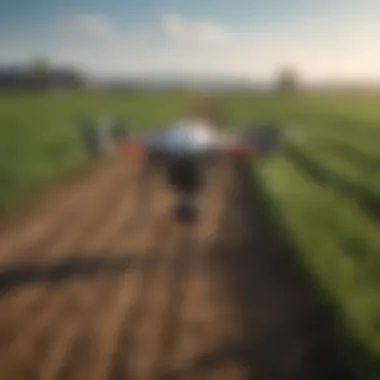
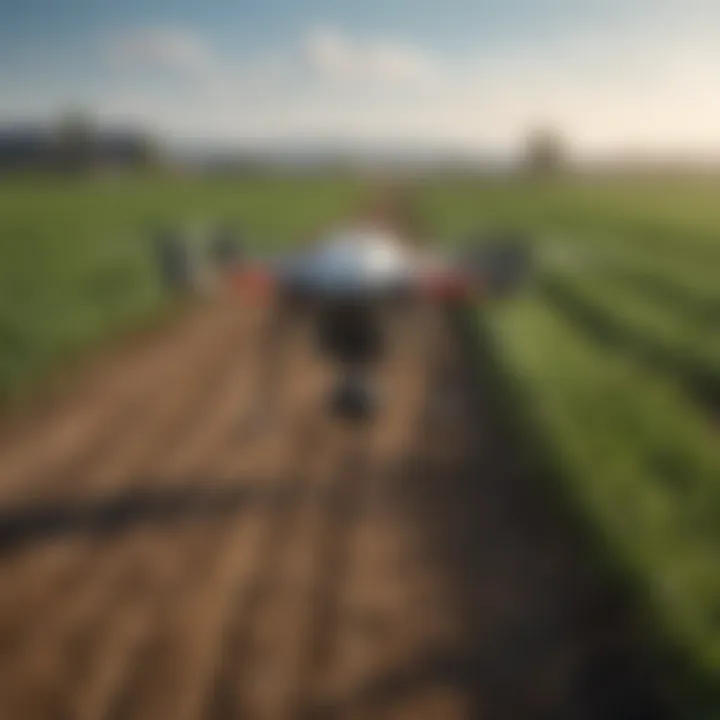
Finally, implementing drone-based disease surveillance entails gathering critical data necessary for effective management strategies. For instance, if a crop shows signs of a fungal disease, a farmer might need to change irrigation practices or choose resistant crop varieties for the next planting season. Drones facilitate timely data collection and analysis, leading to informed decisions that significantly impact overall crop health.
"Utilizing drones for pest and disease control is not merely a trend; it is a shift towards precision agriculture where data-driven decisions lead to sustainable farming practices."
In summary, the integration of drones into pest and disease management frameworks offers farmers an opportunity to adopt modern, efficient methodologies. By enabling earlier detection, allowing precise pesticide application, and enhancing disease monitoring, drones are proving to be indispensable allies in the ongoing battle against agricultural adversaries.
Soil Health and Analysis
Soil health is one of the cornerstones of successful agriculture. It's not just dirt; it's a living ecosystem that supports plant growth, influences crop yield, and affects the overall productivity of farms. With the advent of agricultural drones, soil analysis has taken on a new dimension. These aerial devices can gather data that supports farmers in maintaining and improving soil health, consequently boosting their output and sustainability. Think of it as giving farmers a map of underground riches, waiting to be tapped into profitably.
Soil Composition Assessment
Understanding the composition of soil is paramount for any agricultural practice. Drones equipped with sophisticated sensor technology can fly over fields and create high-resolution maps that reveal the soil's structure.
The key components that make up soil include:
- Sand, Silt, and Clay: The ratio of these particles determines soil texture, affecting water retention and nutrient availability.
- Organic Matter: This is crucial for soil fertility. Healthy soil has a blend of decomposed plant materials and microorganisms.
- pH Levels: Soil acidity or alkalinity affects nutrient uptake. Correct pH levels ensure that plants get what they need to grow.
By analyzing these elements with drones, farmers can pinpoint areas that require amendments or special treatment. For instance, if a specific part of a field has high clay content, it might retain too much water, leading to root rot. This knowledge allows for targeted interventions instead of applying blanket treatments, saving time and resources, ultimately leading to increased crop yields.
Moisture Level Monitoring
Moisture is another critical factor in soil health that drones can monitor effectively. Farmers can utilize drones with thermal imaging cameras to assess moisture levels across their fields. The data gathered helps in identifying dry areas that may need irrigation.
Key Benefits of Moisture Monitoring Include:
- Precision Irrigation: Instead of irrigating the whole field, farmers can target specific areas needing water, promoting efficient use of resources.
- Drought Stress Awareness: Early detection of drought stress can lead to timely interventions, preventing crop losses.
- Soil Moisture Mapping: Knowing the moisture levels helps in planning sowing and harvesting, contributing to overall farm management strategies.
Moreover, moisture maps can be an invaluable asset when planning crop rotation, helping farmers choose the right crops based on the moisture levels in different soils.
Nutrient Mapping
Nutrient mapping is essential for maximizing crop yield and ensuring that the soil is not over or under-fertilized. With agricultural drones, farmers can create detailed nutrient maps of their fields. These maps provide insights into the spatial variability of nutrients across the landscape.
Nutrient mapping provides:
- Insights into Spatial Variability: Different areas of a field may exhibit varying nutrient levels, and drones can help visualize these differences.
- Customized Fertilization Plans: Instead of a one-size-fits-all approach, nutrient data allows for variable rate application of fertilizers, ensuring each section of the field receives the right amount of nutrients.
- Sustainability: By applying fertilizers judiciously, farmers can reduce runoff and improve the long-term health of soil ecosystems.
Reductions in excess fertilizer use help in minimizing environmental impact while also cutting costs for farmers. A win-win in today's agricultural landscape.
"Using drones for soil health analysis turns row-by-row farming into data-driven decision making, enhancing both productivity and sustainability."
As the agricultural landscape continues to evolve, embracing technology like drones for soil health analysis will support farmers in nurturing their land for generations to come.
Water Management
Water management is a critical aspect of agriculture, especially in an era where resources are limited and climate change is a looming concern. Efficient use of water resources can substantially boost crop yield and optimize operational costs. In the context of agricultural drones, the ability to monitor and manage water effectively transforms how farmers approach irrigation and resource allocation.
Irrigation Monitoring
One of the foremost applications of drones in water management is irrigation monitoring. Traditional methods of checking moisture levels can often be time-consuming and labor-intensive. Drones equipped with sophisticated sensors can cover vast swathes of farmland quickly and accurately to measure soil moisture content.
- Precision Analysis: Using thermal imaging and multispectral sensors, drones provide not just a snapshot but a comprehensive view of moisture variability across fields. This precision enables farmers to pinpoint which areas need irrigation and which are sufficiently watered.
- Real-time Feedback: The technology can facilitate real-time data transmission to farmers, allowing them to make quick adjustments to their irrigation systems. This timely information can save substantial amounts of water and reduce costs associated with overwatering.
"With drones, I can see which parts of my fields are thirsty without having to check everything manually," says a farmer who adopted drone technology last season.
Water Resource Assessment
Another crucial aspect is water resource assessment. Drones can aid in evaluating not only the existing water bodies but also the viability of utilizing new ones for irrigation purposes.
- Mapping Potential Sources: Drones collect data about water sources on and around the farmland. This includes rivers, ponds, and even underground aquifers. By analyzing this data, farmers can make informed decisions on where to source water without exhausting nearby supplies.
- Assessing Water Quality: Further, with the right sensors, drones can probe the quality of water available for irrigation. Contaminated water can have damaging effects on soil and crops; thus, understanding the quality is paramount.
Environmental Impact Assessment
Environmental Impact Assessment (EIA) plays a pivotal role in ensuring that agricultural practices harmonize with ecological balance. As modern farming leaps towards integrating technologies like drones, the need to evaluate their environmental impacts becomes crucial. How can one harness the potential of agricultural drones while minimizing their ecological footprint? This is the essential question EIA seeks to answer in the context of aerial farming practices.
The assessment focuses on various dimensions of the environment and scrutinizes possible detrimental effects linked to drone usage in agriculture. For instance, it evaluates how drones might disrupt local wildlife during operations. The noise from flying drones could potentially frighten certain species, leading to shifts in animal behavior. Thus, carrying out biodiversity monitoring becomes a priority.
Additionally, the EIA aids in identifying positive enhancements that drones can offer. For instance, with their capacity for precise data collection, these unmanned aerial vehicles foster better resource management. By analyzing soil conditions and understanding water distribution, farmers can mitigate excess chemical usage that degrades the environment.
Two main aspects within EIA — biodiversity monitoring and habitat assessment — yield insights that are valuable for sustaining agricultural landscapes while protecting natural ecosystems.
"Utilizing agricultural drones responsibly can lead to sustainable farming practices, marrying technology with environmental stewardship."
Recognizing the importance of adopting drones in a way that minimizes harm and maximizes benefits propels the agricultural sector forward. Embracing a thoughtful EIA can guide the integration of drone technology, ensuring that productivity comes hand in hand with ecological responsibility.
Benefits of Using Drones in Agriculture
Agricultural drones are not just a trendy gadget; they bring significant advantages to farming. By leveraging drone technology, farmers can enhance productivity in ways that were hard to imagine only a few years ago. The benefits touch on several critical elements of farming, ranging from operational efficiency to economic considerations and smart decision-making. Here, we will break down three fundamental aspects that underline the essential role drones play in modern agriculture.
Increased Efficiency
The first major perk of using drones in agriculture is the increased efficiency they offer. Drones fly over fields, collecting data much faster than traditional methods. Instead of spending hours inspecting crops on foot or using vehicles, a farmer can assess a large area in a fraction of the time.
Drones are capable of providing real-time visual data, which means farmers can quickly identify problem areas.
- Rapid Surveys: Unlike ground surveys that can take days or weeks, drones can complete assessments in mere hours.
- Precision Application: Drones enable targeted application of inputs like fertilizers and pesticides. This means that instead of blanket coverage, farmers can pinpoint areas needing treatment, increasing overall efficiency.
- Monitoring Growth: Drones equipped with special sensors can monitor crop health, allowing producers to intervene promptly with corrective measures.
"With drones, it’s like having eyes in the sky. Farmers can track every inch of their land without breaking a sweat."
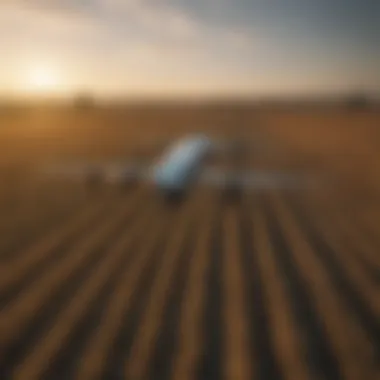
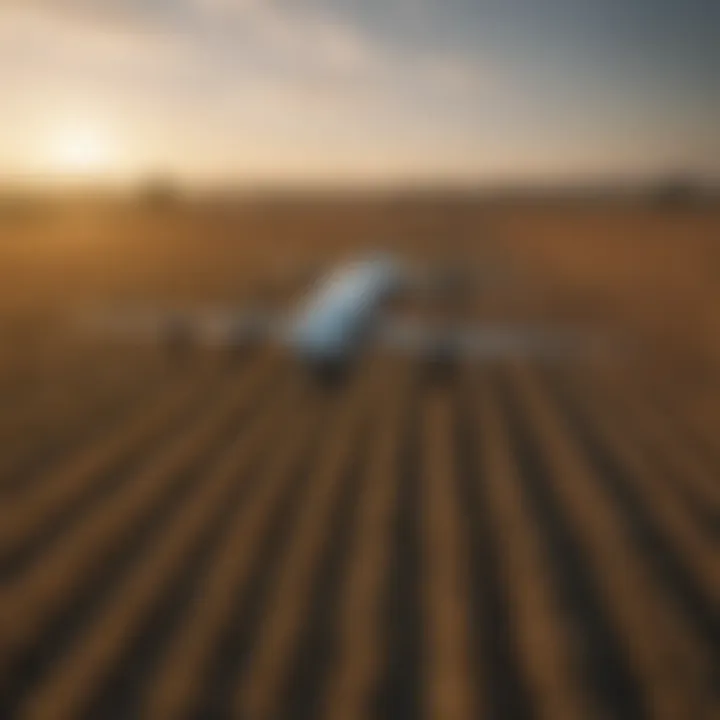
Cost Reduction
When it comes to costs, using drones might seem like a hefty investment at first. However, the long-term savings can be substantial. With more precise management of crops and resources, the financial benefits can improve the bottom line significantly.
- Less Labor Intensive: Drones help reduce the need for manual labor, which can be costly and time-consuming. Workers no longer need to walk miles to check on crops when a drone can do it swiftly.
- Resource Optimization: Targeted applications mean less waste of fertilizers, seeds, and pesticides. By applying only what is necessary where it’s needed, input costs go down.
- Preventing Losses: Early detection of pest infestations or disease can save a farmer from significant losses. Being proactive rather than reactive is a crucial lesson here.
Enhanced Decision Making
Drones equip farmers with valuable data that enhances their decision-making capabilities. The data collected can offer insights that transform how farming decisions are made, steering well-informed strategies.
- Data Visualization: Drones can produce high-resolution imagery that helps visualize field conditions in ways that ground-level observation cannot. This clarity allows for better analysis and strategy formation.
- Long-term Planning: By analyzing trends over time, farmers can make more strategic decisions for future planting and crop management strategies. It’s all about forecasting based on solid data.
- Collaboration with Experts: Drones facilitate easier sharing of data with agronomists or consultants. This collaboration can lead to better outcomes since experts can provide tailored advice based on the latest insights.
Challenges and Limitations
Agricultural drones are at the forefront of modern farming innovation, yet they aren't without their hiccups. Addressing the challenges and limitations is crucial for farmers and agricultural enthusiasts who lean on these technologies. Fully grasping these issues helps in fostering informed decisions and preparing for what's up ahead. Here, we delve into three key aspects: regulatory restrictions, technological barriers, and market readiness.
Regulatory Restrictions
Navigating the legal landscape is often like wading through a thicket—one misstep can lead to trouble. Governments around the globe have implemented varying rules governing airspace usage, drone certifications, and data privacy. In the United States, for example, the Federal Aviation Administration (FAA) requires all commercial drone operators to obtain a Remote Pilot Certificate.
Some of the notable implications of regulatory restrictions include:
- Restricted Flight Zones: Many areas, such as near airports or urban centers, impose flight restrictions which can limit operational efficiency.
- Data Usage Limitations: Farmers need to be wary of regulations regarding data collection and use, which varies from state to state.
- Certification and Training Requirements: Compliance with training protocols slows down the adoption for those not yet familiar with drone technology.
Understanding these regulations is essential for effectively utilizing drones in agriculture while staying on the right side of the law.
Technological Barriers
The technological landscape of agricultural drones is continually evolving, but there are still several hurdles to overcome. From hardware to software, farmers face challenges that can hamper effectiveness. Relying on advanced technology often also entails dealing with a steeper learning curve. Consider the following:
- Quality of Sensors: Inconsistent sensor quality can significantly affect the accuracy of data collected, leading to potential missteps in crop management strategies.
- Battery Life Constraints: Many drones are limited by their battery life, which can restrict the size of the area that can be monitored in a single flight.
- Integration with Existing Systems: Farmers often rely on established management systems, and integrating new drone technology can be complex and costly.
Bridging these gaps is vital for maximizing the potential of drones in boosting productivity and sustainability.
Market Readiness
The agricultural drone market is still maturing, and how quickly it can deliver value doesn’t come without its uncertainties. While drones have gained traction, a disparity remains in the adoption rate across various regions. Factors influencing this include:
- Cost of Equipment: High upfront costs can deter smaller farms from investing in drones, creating a barrier for broader industry uptake.
- Perception of Effectiveness: Some farmers are skeptical about the efficacy of drones and whether they deliver the promised benefits, leading to hesitation in investment.
- Access to Training and Resources: A shortage of readily available training programs means that even interested individuals may feel ill-equipped to use drone technology effectively.
"Tackling these market readiness issues is crucial for fostering widespread adoption of drone technology in farming, ensuring that the benefits are within reach for every farmer."
In summary, addressing these challenges—regulatory restrictions, technological barriers, and market readiness—will substantially assist stakeholders in optimizing their use of agricultural drones, driving an innovative approach to modern farming. Ignoring them could lead to significant disruptions in the adoption process, hurting the potential advances these tools could bring to the table.
Future Trends in Agricultural Drones
The landscape of agriculture is shifting rapidly thanks to the advent of drone technology. Recognizing the importance of future trends in agricultural drones is essential for both farmers and enthusiasts. As we move into an era dominated by data and precision, the innovations in drone technology will set a new standard for efficiency and sustainability in farming practices. By understanding these trends, agricultural professionals can better prepare for the changes that lie ahead, ultimately leading to improved crop yields and resource management.
Advancements in Drone Technology
Drones have come a long way from their initial designs. The latest advancements focus on enhancing operational capabilities, which opens up new avenues for practical applications. Key examples include:
- Improved Battery Life: Recent innovations in battery technology enable drones to stay airborne longer, thereby covering larger fields.
- Enhanced Payload Capacity: This allows for the deployment of more sophisticated sensors and imaging equipment, providing richer data for analysis.
- Swarm Technology: Utilizing multiple drones working in unison can drastically reduce the time needed for monitoring and data collection, especially in larger farming environments.
These advancements not only streamline the workflow but also allow farmers to harness data more effectively. The integration of more sophisticated tools means less guesswork in farming decisions, ultimately leading to better resource use and healthier crops.
Integration with AI and Machine Learning
Integrating artificial intelligence and machine learning into agricultural drones represents a paradigm shift in the way data is processed and utilized. AI algorithms can analyze vast amounts of data collected from the field, identifying patterns that may not be visible to the naked eye. This can benefit agriculture in various ways, such as:
- Predictive Analytics: By analyzing historical data, drones can help predict weather changes and pest infestations, allowing farmers to act preemptively.
- Automated Decision-Making: With machine learning, drones can make informed decisions about when to irrigate or apply pesticides, maximizing efficiency and reducing waste.
- Enhanced Mapping Techniques: Advanced algorithms can create detailed crop maps, demonstrating plant health in real-time, thus helping farmers allocate their resources intelligently.
This synergy between drones and AI promises not only time-saving solutions but also precision-based farming that is fundamentally more sustainable and profitable.
Sustainability Considerations
As agriculture faces increasing scrutiny over its environmental impact, sustainability has become a hot topic within the realm of agricultural drones. The following aspects highlight the significance of incorporating sustainability into drone technology:
- Reduced Chemical Use: Targeted pesticide applications enabled by drones minimize the amount of chemicals needed. This approach not only cuts costs but also lessens environmental pollution.
- Water Conservation: Drones equipped with moisture sensors can monitor water levels and help in enhancing irrigation strategies to prevent waste, particularly in drought-prone areas.
- Carbon Footprint Reduction: By optimizing resource use and minimizing the need for heavy machinery, agricultural drones can significantly lower the carbon footprint associated with traditional farming practices.
As farmers look forward, aligning the use of drones with sustainability goals could become a necessity as consumers increasingly demand eco-friendly produce. The broader acceptance of this technology may hinge on its ability to deliver not just productivity but also sustainability without compromise.
"Future advancements in agricultural drones will not just change how we farm, but redefine what farming means to the planet."
The thoughtful integration of these elements sets the stage for a new chapter in agriculture – one where technology meets sustainable ideals, positioning both farmers and drones at the forefront of a wise and effective future.
Closure
In reflecting on the diverse applications and implications of agricultural drones, it becomes clear that these tools are not merely gadgets; they represent a seismic shift in modern farming practices. The importance of integrating drone technology in agriculture hinges on several pivotal factors that redefine productivity, resource management, and sustainability.
Summation of Key Insights
Drones have significantly enhanced various facets of agriculture:
- Precision in Farming: By employing precision ag techniques, farmers can minimize waste and optimize input usage. Drones equipped with specialized sensors facilitate real-time monitoring that allows for swift interventions, reducing the risk of crop loss.
- Environmental Monitoring: As environmental concerns take center stage, agricultural drones play a crucial role in assessing biodiversity and habitats. This insight helps farmers make informed decisions supporting both ecological health and productivity.
- Cost-Effectiveness: The initial investment in drone technology may seem steep, but the long-term savings in labor and resource efficiency often outweigh these costs. Many farmers report a shorter return on investment due to reduced reliance on traditional practices.
Overall, the tools highlight a new era in farming, where data-driven decisions supersede guesswork. Through the lens of technological advancement, the agricultural sector is transforming into an industry that is not only functional but significantly more sustainable.
Call to Action for Engagement
As we navigate through the intricate landscape of agricultural technology, it's imperative for farmers, agricultural professionals, and enthusiasts to embrace these innovations openly. Engaging with drone technology isn't solely about integration; it's about forming a community that shares knowledge and resources. Here are some steps to consider:
- Educate: Stay informed about the latest drone technologies and their applications. Online platforms such as Wikipedia and Britannica offer valuable insights into drone advancements.
- Participate: Participate in forums found on platforms like Reddit where agricultural technology trends are discussed. Collaborating with others can spark new ideas and solutions.
- Experiment: If you're curious about drones, consider starting small. Try out basic models to understand their functionality, then slowly adapt them to suit your farming needs.
Let’s bridge the gap between traditional agricultural methods and the technological innovations available today, ensuring that the future of farming is bright, efficient, and sustainable.



